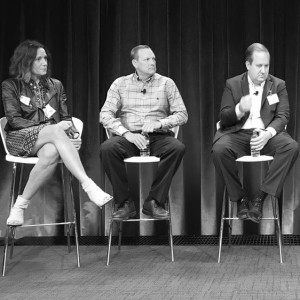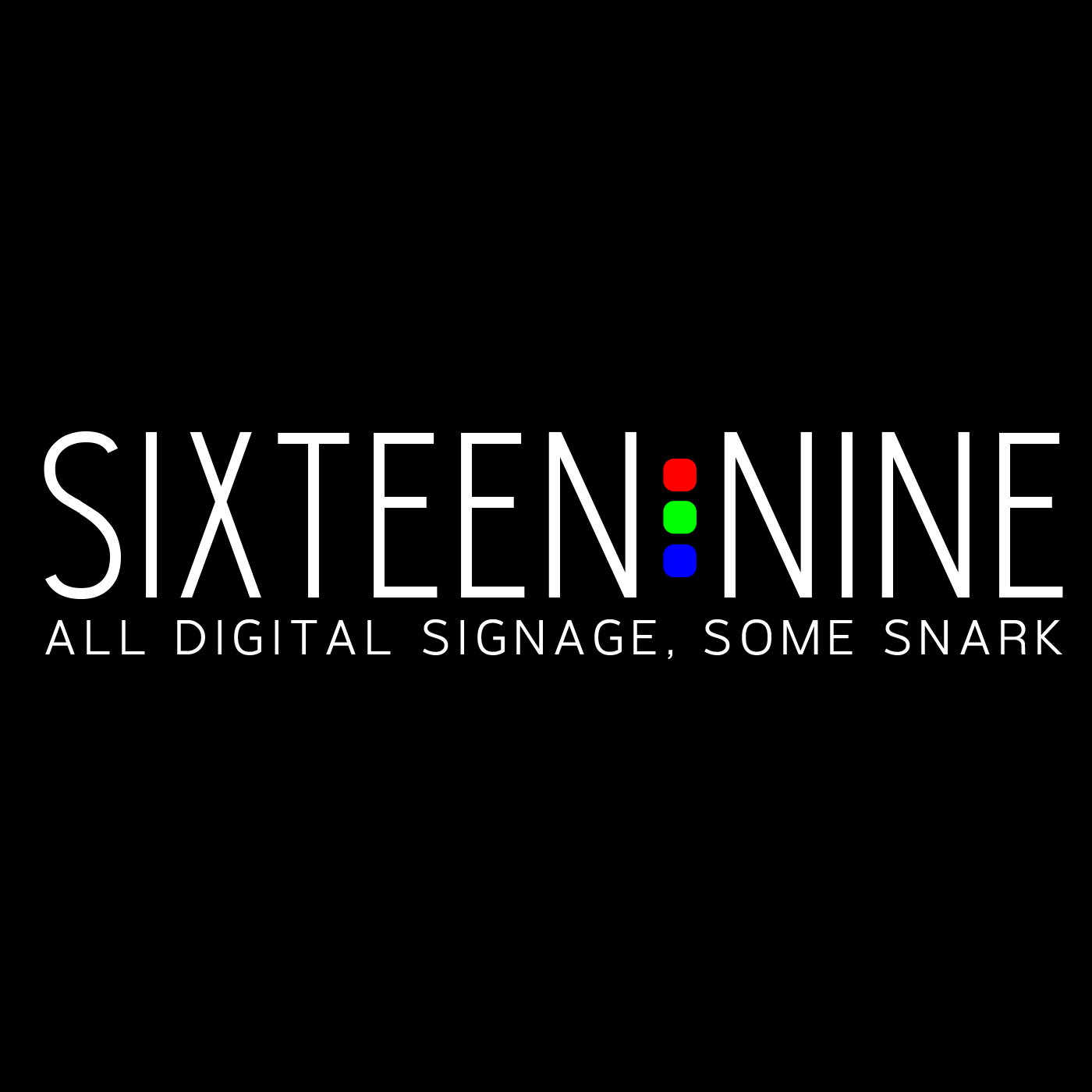Episodes

Wednesday Jan 16, 2019
Leo Resig, Chive Media
Wednesday Jan 16, 2019
Wednesday Jan 16, 2019
The big selling point for Chive TV is that the streaming channel's five-hour mix of curated social media content keeps butts in barstools.
The Austin, Texas-based company has some 4,000 bar and restaurant venues running content on one or many of their TVs, and about 500 more come on monthly - with a lot of that growth through word of mouth.
Now Chive has broadened its free streaming content offer beyond just bars - adding venues like gyms, medical clinics and workspace break rooms. There will soon be 10 different channels of content on what's now branded as Atmosphere TV.
Chive was founded about a decade ago by two brothers, and I spoke with one of them - Leo Resig - about how it all started, why they created a streaming TV channel, and how charitable work is a big part of what they do.
Subscribe to this podcast: iTunes * Google Play * RSS

Wednesday Jan 09, 2019
Angela Vanderburg, Q Division
Wednesday Jan 09, 2019
Wednesday Jan 09, 2019
This week we look at how the financial services industry is using digital signage in branches, and more to the point, what works and why.
Angela Vanderburg is the Digital Practice Lead for Consumer Banking and Retail Financial Services for Q Division, the retail-focused digital strategy consultancy that was launched by STRATACACHE. She's a shameless digital signage nerd who endlessly studies how the technology is used and the content choices that were made on networks, all the way down to locations.
We're talking because Vanderburg guided a pair of very significant research exercises in Europe and North America that got insights and data from consumers, and from decision-makers at banks.
In this episode, you'll hear about what the research revealed, why stuff like weather reports actually work well for banks, and how things that I maybe think are gimmicks are, in fact, worthwhile.
Subscribe to this podcast: iTunes * Google Play * RSS

Wednesday Dec 19, 2018
Kim Sarubbi, Cannabis Medical Network
Wednesday Dec 19, 2018
Wednesday Dec 19, 2018
Screens in medical waiting rooms is one of the most well established kinds of digital OOH media, and there's been no end of companies that developed networks built around advertising-supported content.
That's now happening in the United States with medical cannabis clinics, through a pair of signage industry vets who have applied what they learned in mainstream medical centres to clinics focused on cannabis products - as alternatives to things like opioid medications.
Kim Sarubbi has been working with Phil Cohen on medical center content for a quarter century, and answered Cohen's call when he said he was getting back into waiting rooms aimed at the emerging cannabis market, via the Cannabis Medical Network.
They are already in roughly 1,000 clinics with a screen, media player and custom-created content that's designed to educate patients about the potential benefits of cannabis for battling things like PTSD or easing the pain or effects of cancer, epilepsy or other diseases.
I spoke with Sarubbi about the challenges of operating in a still emerging industry and market where the rules can vary, the product gets looked at with raised eyebrows, and the snake oil crowd can easily intermingle with the makers of much more proven and established products and treatments.
Subscribe to this podcast: iTunes * Google Play * RSS

Wednesday Dec 12, 2018
Kaan Gunay, Firefly
Wednesday Dec 12, 2018
Wednesday Dec 12, 2018
There's nothing new about media on taxi tops, but a San Francisco start-up called Firefly is trying to go about it with a different approach.
Firefly describes itself as the first mobility-based SmartScreens platform - an advertising media firm that gets it footprint and scale from the rideshare industry.
Firefly is working primarily with the drivers for services like Uber and Lyft, offering a supplemental revenue stream in return for fixing a hyper-local, geo-fenced digital sign on the cartop. Firefly absorbs the capital cost, and spins off an average of $300 a month to the driver. That money isn't huge, but it can be enough to significantly offset leasing or insurance costs and make driving for a living worthwhile.
Co-founder Kaan Gunay is a mechanical engineer by training, but in recent years has found his way to Stanford, where he got his MBA and where the roots of Firefly first developed. He's also very active in community good works, and we spoke about how continuing that was, and is, fundamental to how Firefly does things.
At least 10 percent of all media on screens goes to to promote and advertise local not-for-profit organizations and provide public service announcements for non-commercial entities such as charities.
The car-toppers have sensors - for things like air quality - that generate data that's open for government planners, and others, to use.
I spoke with Gunay last week, just as his company was announcing a big $18.5 million seed funding raise.
Subscribe to this podcast: iTunes * Google Play * RSS

Wednesday Dec 05, 2018
Kaijus Asteljoki, Valotalive
Wednesday Dec 05, 2018
Wednesday Dec 05, 2018
Workplace communications is one of the most active verticals in digital signage, and a big reason for that is the ability of screen technology to get important information to staff - without hoping they open and read mass emails or see posters on breakroom cork boards.
The Finnish startup Valota saw the rise in business-based digital signage coming, and has been developing a product totally focused on visual messaging in the workplace.
Based outside Helsinki, the company's Valotalive product is a messaging platform built around a growing set of content presentation apps that visualize data from widely used business systems like Salesforce and Microsoft's Power BI.
The platform enables set it and forget it content that's fed via these systems - so when the KPIs for a company change, they change automatically on screens located around facilities. It's a big step up from Happy Birthday wishes and notices about the parking lot being paved on the weekend.
I spoke with CEO Kaijus Asteljoki about the roots of Valotalive, and what he says are the key things end-users need to think about when putting together a digital screen network for their workplaces.
Subscribe to this podcast: iTunes * Google Play * RSS

Wednesday Nov 28, 2018
Ryan Croft, TransitScreen
Wednesday Nov 28, 2018
Wednesday Nov 28, 2018
This is inadvertently turning into transit digital signage month on this podcast, having spoken lately with CHK America about epaper transit signs and just last week with Roadify, which aggregates data from transit systems.
This week I'm talking to Ryan Croft, one of the co-founders of TransitScreen, which has made a mark in North America and globally with a subscription service that puts together and presents on screens all the mobility options for people at specific venues.
What that means in practical terms is people coming down in late afternoon to the lobby of their office block, and looking at a carefully-considered and laid-out screen that shows everything from the state of local buses and trains to the availability of Uber, Lyft and some of the other alternative transport options out there these days.
In our chat, we get into how TransitScreen got started, what they've learned along the way, why they've now added a mobile app, and how the sort of data insights all this mobility data is generating might have some interesting new uses.
Subscribe to this podcast: iTunes * Google Play * RSS

Wednesday Nov 21, 2018
Scott Kolber, Roadify
Wednesday Nov 21, 2018
Wednesday Nov 21, 2018
Mass transport data is some of the stickiest content out there for digital signage screens. It's information people tend to want and need, and they'll habitually look at screens to get it.
Tapping into the open data from one transport authority, to show it on screens, is relatively easy. It gets more complicated when you want to show data from multiple systems on a screen, and it gets quite complicated when the signage network wants to run data specific to different cities and different transit systems.
It would be a bear for a software or solutions company to take on, which is the attraction of a Brooklyn-based service called Roadify - which aggregates all that data from different systems and presents it all in one structured format, using its platform and running off a subscription model.
The service is similar to some of the news, weather and sports feed aggregators that have long operated in this sector, except the content is quite different. I spoke with founder and CEO Scott Kolber about the roots of Roadify, and how his company's services are being used.
Subscribe to this podcast: iTunes * Google Play * RSS

Wednesday Nov 14, 2018
Beth Warren, Creative Realities
Wednesday Nov 14, 2018
Wednesday Nov 14, 2018
Beth Warren of Creative Realities - or CRI for short - came recommended as a speaker for the DSF's recent Coffee and Controversy event in New York.
We'd never met, and while in New York, I seized the opportunity to meet up with her after the event to talk a lot about digital signage in retail - from her longtime lens as the Senior VP of Experience Planning at CRI.
She comes out of the agency world, so she approaches signage in retail from a different perspective and set of learned experiences and observations. We go fairly deep in our chat into what experience actually means - and what genuinely works in retail, versus some of the trickery and gadgets that get touted as delivering "engagement."
We also get a little into what CRI does, and the many twists and turns of its recent history. The company has evolved, and now positions itself very much as a solutions provider that can take retailers from the need and idea through to lighting up the visuals and measuring the impact.
Subscribe to this podcast: iTunes * Google Play * RSS

Wednesday Nov 07, 2018
2018 DSF Coffee and Controversy, in NYC
Wednesday Nov 07, 2018
Wednesday Nov 07, 2018
I was in New York last week for the Digital Signage Federation's annual Coffee and Controversy breakfast event - a panel discussion that each year brings together some of the most influential leaders in the digital signage industry.
I'm on the DSF board and my fellow board members drafted me to run the panel - with Chris Riegel of STRATACACHE, Jeff Hastings of Brightsign and Beth Warren of Creative Realities.
There's only so much controversy you can whip up around digital signage, but I tried ... and if anyone in this industry was going to stir up some shit, it was Chris. He didn't disappoint, nor did Jeff or Beth.
The women who ran the AV for the event very kindly generated an audio recording for me. This is about twice the length of a normal 16:9 podcast, but if you didn't have the chance, time or budget to get to New York last week, you can have a listen to what was said.
Subscribe to this podcast: iTunes * Google Play * RSS

Wednesday Oct 31, 2018
Rich Ventura, NEC Display, on ALP
Wednesday Oct 31, 2018
Wednesday Oct 31, 2018
NEC Display has been fairly quietly involved in analytics for a long time now, but it just got very serious and noisy about that capability, with the launch of something called ALP - which is short for Analytics Learning Platform.
It's a retail intelligence program that uses cameras and other sensors, AI, big data, cloud computing and network appliances to give retailers a better sense of what's going on in their stores.
Tied to digital signage, a retail intelligence platform can optimize messaging based on who's in there, how long they're in there, and the historical patterns of what those people tend to buy. The gold for retail operators is understanding conversion ratios - the what really happened stuff when messages were pushed.
There is no shortage of retail intelligence platforms out there, but none that I know of built from the ground up with signage as a core element. I spoke with NEC's Rich Ventura, who drove the project, to talk about ALP's roots, how people in the signage ecosystem plug in, and how it all fits.
Subscribe to this podcast: iTunes * Google Play * RSS

Wednesday Oct 24, 2018
Rick Wood, CHK America
Wednesday Oct 24, 2018
Wednesday Oct 24, 2018
Rick Wood's company was founded to bring some order and logic to how mass transport systems present information - like routes and schedules - to passengers.
It was a tall order for CHK America - because many or most transport authorities had their own way of doing things, and not that many were particularly good at making it easy and familiar for people to find their way around.
But the company has seen a lot of success, and its best practises have been widely adopted. When people take unfamiliar buses and subways in cities they visit, there's a reasonable chance the information on the signs they see now look familiar and can be readily understood. Ideally, CHK says people should be able to find out what they need in eight seconds.
It's a mindset smart digital signage people have come to understand ... in essence, you have a matter of a few seconds to inform people before they look somewhere else.
All the understanding of how people seek and consume information is now being applied by CHK, through a spinout called ConnectPoint, to digital displays. The company started with big interactive screens, but now the really interesting work is with dynamically-updated, solar-powered e-paper signs at bus stops.
In this week's podcast, I spend a lot of time talking to Wood about how mass transit users find and use information, and how all this translates from static to digital displays.
Subscribe to this podcast: iTunes * Google Play * RSS

Wednesday Oct 17, 2018
Matt Downey, Freshwater Digital
Wednesday Oct 17, 2018
Wednesday Oct 17, 2018
Matt Downey's time in digital signage traces way, way back to the days when Premier Retail Networks was, by far, the big dog in putting screen networks in retail environments.
His time with PRN - working with clients like Walmart - eventually led him into working directly for one of his big grocer clients. Not long after that, he took a leap and started his own company. I'd say it was a big leap, but he started out with a whale client - his current employer.
Many years later, Freshwater Digital is a well established digital signage solutions provider, with double-digit growth every year and a client list that's rich in big companies that's not only local to Grand Rapids, Michigan, but also includes organizations that are much further afield.
Matt and I get into the roots of Freshwater, and lessons learned. We also go pretty deep into a new area he's going after in a big way - e-paper tags and shelf labels.
Subscribe to this podcast: iTunes * Google Play * RSS

Wednesday Oct 10, 2018
Jeffrey Martin, Right Media Solutions
Wednesday Oct 10, 2018
Wednesday Oct 10, 2018
Jeff Martin has been around the digital signage industry for pretty much as long as the industry has existed - running the ops side of some very large retail networks.
He was one of the co-founders of SignStorey, which at its peak ran screen networks in a wide range of groceries across the United States in the early to mid-2000s. That company was acquired in 2007 by CBS, which turned into Outfront. It was a BIG deal at the time, with CBS paying more than $71 million for a digital signage company ... 11 years ago.
In 2011, Martin went out on his own and got ahead of a trend towards managed services and solutions, founding what is marketed as Right Media Solutions. Based in New England, the company runs the digital signage networks for multiple clients, across all 50 states.
I had a great chat about the old days of digital signage, particularly in grocery stores. We talk about what worked then and what works now.
Subscribe to this podcast: iTunes * Google Play * RSS

Wednesday Oct 03, 2018
Peter Livesey, Esprit Digital
Wednesday Oct 03, 2018
Wednesday Oct 03, 2018
Anyone with technical chops who uses a subway system to get around would understand that those are seriously challenging environments to put in sensitive display technology - and the UK display technology company Esprit Digital effectively got its start in digital signage doing just that.
If you have been in the signage market for a few years, or if you have used the subway systems in big cities like London, you'll know about the synchronized digital posters in many of the escalator sections. The most well-known are those in the London Underground, which were put in by Esprit many years ago and are still working.
The company, based north of London, has built out its business from everything it learned about heat and airborne grime and ruggedization, and has since developed products for shopping mall concourses, sidewalk ad posters and all kinds of other challenging scenarios.
I spoke with CEO Peter Livesey about the roots of the company, which go back to really low-rez LED signs for retail, and how the company has gone full-circle and added fine pitch indoor and outdoor LED screens to its product line.
Subscribe to this podcast: iTunes * Google Play * RSS

Wednesday Sep 26, 2018
Mark Bennett, MicroGigantic
Wednesday Sep 26, 2018
Wednesday Sep 26, 2018
In an industry that has, for years, had people endlessly blabbering away about how Content Is King - my God that's clever! - it's amazing to me how I can count the number of pure-play digital signage creative shops on one hand.
MicroGigantic is one of those rare shops - a Minneapolis, Minnesota-based boutique agency that does visual storytelling for brands - whether that's retail or corporate.
The company's roots are with one of the biggest brands in the Twin Cities - the mass merchandising retailer Target. Mark Bennett managed the Media Production group at Target - and a big part of that was feeding the many screens sprinkled around the huge stores.
It was a great gig, Bennett says, but he got the seven-year itch to go out on his own, and started MicroGigantic knowing there wasn't a lot of competition for what he wanted to do.
His team does retail, but the real growth these days is for work in areas like corporate - with companies looking to make visual statements about what they do, and what they're about.
Subscribe to this podcast: iTunes * Google Play * RSS

Tuesday Sep 18, 2018
Hongwei Liu, Mappedin
Tuesday Sep 18, 2018
Tuesday Sep 18, 2018
Wayfinding is one of those core technologies that make consumer lives better and easier - helping people locate where they want and need to go in places like shopping malls, airports, health care facilities and higher ed campuses.
There are numerous software companies that include wayfinding capabilities in their platforms, but only a handful that have been laser-focused just on delivering that solution. One of the most successful ones is Mappedin.
The company started as a sideline for some students at the University of Waterloo, which most observers would call the top computing school in Canada. Hongwei Liu and his buddies thought they could solve a problem for students finding their way around the sprawling Waterloo campus, and then at a local mall and a casino a couple of hours up the highway.
There was enough there for Liu to quit school in his second year. Just a few years later, he's running a company with 60 employees, some big outside investors, and clients across North America and globally.
I spoke with Liu about Mappedin's roots, what works and doesn't, and how the big moment came when serious research showed good wayfinding can mean millions of dollars in incremental sales for shopping malls and their tenants.
Subscribe to this podcast: iTunes * Google Play * RSS

Wednesday Sep 12, 2018
From The Archive: Michael Schneider On Experiential Digital Design
Wednesday Sep 12, 2018
Wednesday Sep 12, 2018
No new podcast this week ... sorry.
I had two postponed interviews last week, combined with a short work week and then me spending two of those four days in a succession of airplanes getting to and from a client. I'm kinda remote now, and so are they.
I have two chats scheduled for Thursday, and more in the hopper. I'm also happy to get suggestions on people/companies I should be making subjects of an episode, so send your suggestions along.
That stated, it's an archive week. Enjoy this podcast chat from late 2016 with Michael Schneider, who was with the experiential design firm ESI Design at the time, but sent me a note last week to say he's joined the NYC office of the big, global architecture and design firm Gensler, as Creative Technology Director – Hardware.
He's left a great firm, but gone to another great one. Smart, soft-spoken guy, involved with some phenomenal projects.

Wednesday Sep 05, 2018
Henrik Andersson, Instore Screen
Wednesday Sep 05, 2018
Wednesday Sep 05, 2018
Retail is one of the most-chased vertical markets in all of digital signage, but if you ask people who really know this tech, but also really know retail, they'll tell you they've rarely seen it done well, or right.
I tend to agree, and sometimes its not the whiz-bang flashy stuff that makes a difference, but the more pedestrian stuff that does the whole right message/right time thing.
A company called Instore Screen has been chasing retail for many years, and has learned what's needed and works, and developed a product that specifically fits the retailer and consumer brand ask. It does screens that fit the sightlines, limited space and operating realities of grocery, drug and mass merchandise. The high-resolution screens enable the kind of full-motion, eye-grabbing content that drives impulse purchases.
The company's core product is custom-manufactured, pixel-dense LCD screens that fit easily into things like grocery aisle endcaps. Based in Hong Kong, Instore Screen has some top tier customers like Whole Foods, which is using end-cap screens in its new-build stores to explain products and drive sales.
I spoke with Henrik Andersson, the founder and CEO of the 15-year-old company. We get into the technology, shopping dynamics and the argument for LCD over LED as shelf-edge displays.
Subscribe to this podcast: iTunes * Google Play * RSS

Wednesday Aug 29, 2018
Refik Anadol, On Digital Data Sculptures
Wednesday Aug 29, 2018
Wednesday Aug 29, 2018
If finding a free half-hour to talk is any indication, Refik Anadol is one busy, popular guy right now. That likely owes a lot to the mind-blowing data visualization work he's been doing lately in public spaces.
He's a Turkish-born digital media artist who now has a busy studio in Los Angeles doing what he calls parametric data sculptures for public art spaces.
If you have been in downtown San Francisco, you may have seen a big LED video wall in the lobby of a Salesforce tower that seems to have a corner glass window with live expanding foam - or something. It looks real, but it's just three-dimensional digital art, driven by data.
More recently, he's done several sync'd up visualizations on the LED walls of an expanded section of Charlotte, North Carolina's airport. What's happening on the screens there is all based on real-time data from airport operations. So what you see on the screens is shaped by things like luggage-handling systems.
Kinda crazy.
I caught up with Anadol recently at his LA studio, to get a sense of what he and his team does, and we have a broader discussion about visualized data.
Subscribe to this podcast: iTunes * Google Play * RSS

Wednesday Aug 22, 2018
Pierre Gendron, Stingray Media
Wednesday Aug 22, 2018
Wednesday Aug 22, 2018
tingray Digital Media Group is one the world's biggest providers of multi-platform music services, with 11,000 commercial clients in 156 countries.
The Montreal company's core business is piped-in music channels for commercial and residential, but it also has a growing operation in digital experiences for retail - like flashy screen networks in big Canadian sporting goods stores.
That side of the business is led by Pierre Gendron, a former pro hockey player who found his way into digital signage doing an early version of it for company golf tournaments around Quebec. That company evolved and developed into Groupe Viva, which was then acquired in 2015 by Stingray.
Now part of a much larger organization, Gendron talks in this chat about what Stingray offers and how it intends to grow. One of those ways is through acquisition, and we get into why Stingray recently bought Toronto-based NovraMedia, which gives the company a big national bank customer and a stronger digital signage foothold in English Canada and beyond.
Subscribe to this podcast: iTunes * Google Play * RSS


